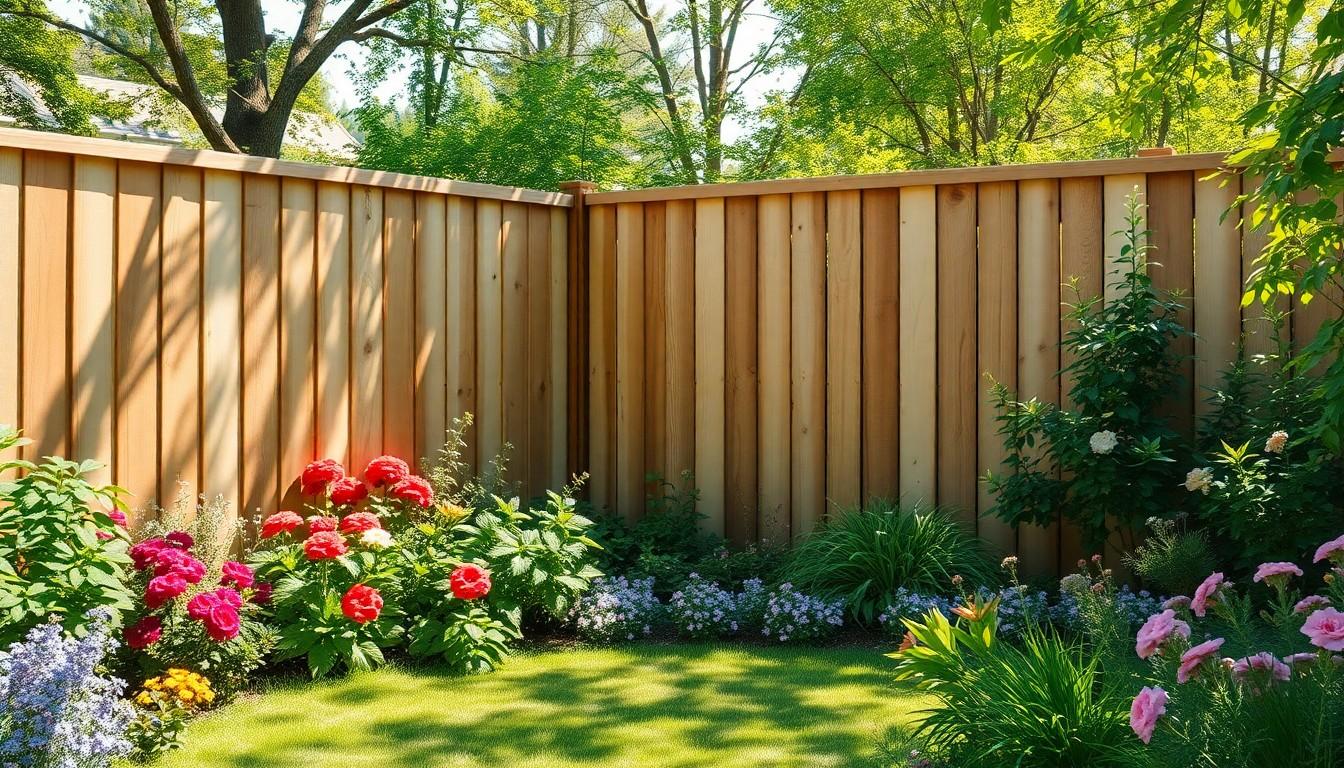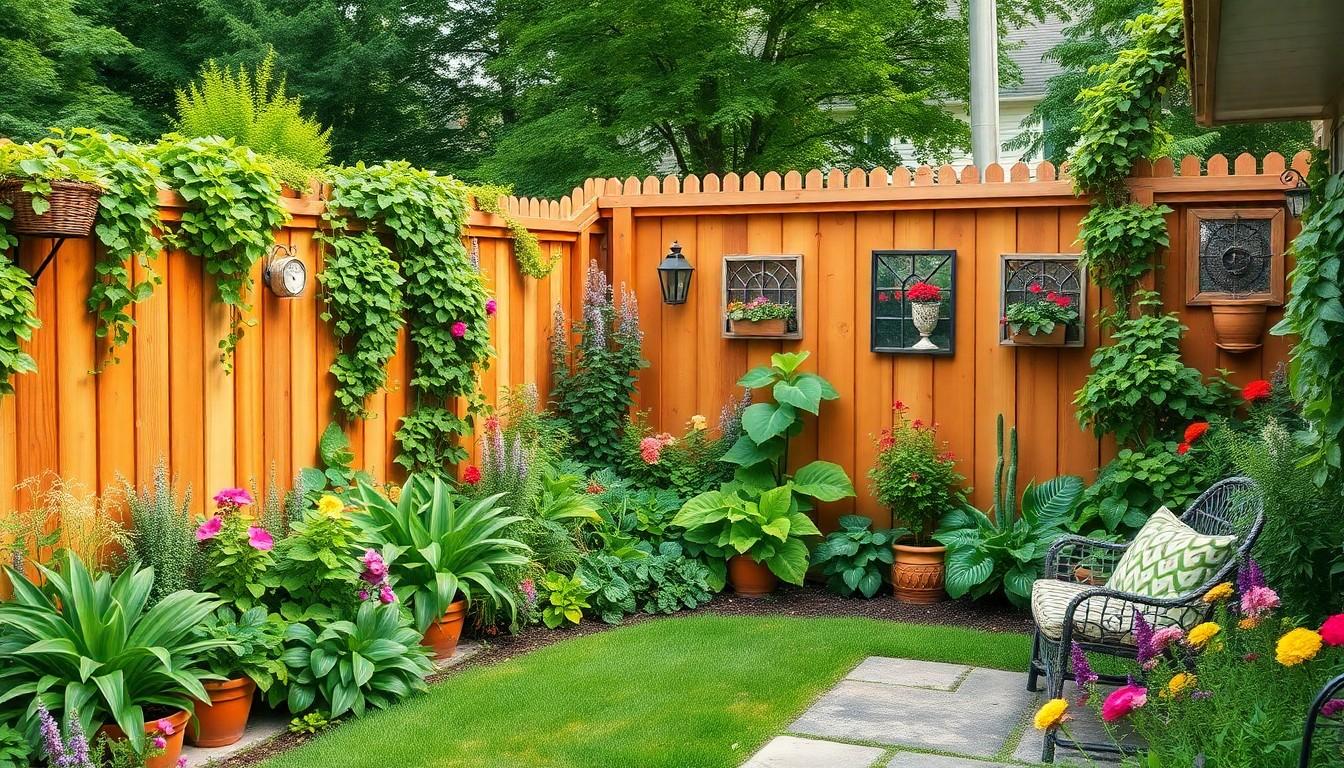Transforming a living space into a vibrant garden oasis can feel like a Herculean task, but it doesn’t have to be. Picture this: lush greenery, colorful blooms, and a fence that not only keeps the neighbors from borrowing your tools but also adds a touch of charm. A well-designed fence garden can be the secret weapon in your backyard arsenal, turning an ordinary space into a delightful retreat.
Living Spaces Fence Garden
Transforming a living space into a fence garden creates an inviting outdoor sanctuary. A fence plays a critical role in defining the garden’s boundaries, enhancing both privacy and aesthetics. With a variety of fencing options available, homeowners can choose materials that complement their garden design, such as wood, vinyl, or wrought iron.
A well-constructed fence adds structure to the landscape while protecting plants from harsh weather and local wildlife. It acts as a barrier against pets, ensuring that plants remain safe and undisturbed. Furthermore, decorative elements like trellises and lattice can be integrated into the fence design, allowing climbing plants to flourish.
Incorporating a fence into a garden not only increases functionality but also elevates the garden’s overall appearance. Different fence heights and styles can create distinct atmospheres. For example, a tall wooden fence offers seclusion, while an open picket fence invites visitors to enjoy the view.
The placement and design of the fence should reflect individual preferences and the surrounding environment. Using plants and flowers alongside the fence enhances natural beauty. Gardeners can select low-growing shrubs or colorful blooms to create a harmonious look.
Creating a living spaces fence garden encourages sustainability. Incorporating native plants fosters local biodiversity while reducing maintenance needs. This approach also contributes to a healthier ecosystem, as native plants require less water and care.
Selecting the right fence is essential for defining the character of the garden. Those who desire a rustic look may opt for weathered wood, while minimalist designs might call for sleek metal options. Ultimately, the fence serves as a canvas for creativity, allowing individuals to express their style through their garden.
Benefits of a Fence Garden

A fence garden delivers multiple advantages, enhancing both the functionality and beauty of outdoor spaces.
Enhanced Privacy
Privacy becomes a priority when creating a tranquil outdoor retreat. A solid fence acts as a shield against prying eyes, allowing individuals to enjoy their gardens without feeling exposed. Homeowners often appreciate taller fences that provide more seclusion. These structures can also dampen noise from nearby streets or neighbors. In addition, installing a fence encourages a sense of safety for children and pets, fostering worry-free enjoyment of the garden.
Aesthetic Appeal
A fence garden contributes significantly to visual charm. Various materials, such as wood, vinyl, or wrought iron, offer style options that complement any garden design. Decorative elements like trellises and lattice not only enhance beauty but serve functional purposes as well. Different colors or finishes on fences create diverse atmospheres, shaping the overall look and feel of the garden. Selective planting near fences can further elevate aesthetics, blending natural greenery with structured designs.
Pest Control
Pest management benefits from a well-constructed fence. By creating a barrier, fences deter unwanted animals from entering the garden. Common nuisances like rabbits and deer may find it harder to breach sturdy enclosures. Additionally, fences can limit the access of insects by establishing controlled garden boundaries. Homeowners often find that a thoughtful fence contributes greatly to protecting vulnerable plants and maintaining their garden’s health.
Types of Fences for Garden Spaces
Fences come in various styles and materials, each offering unique benefits for garden spaces. Choosing the right type can significantly influence both functionality and aesthetics.
Wooden Fences
Wooden fences provide a classic look that blends seamlessly into garden environments. Common choices include cedar and redwood, known for their durability and resistance to decay. These fences can be painted or stained, allowing customization to match the garden’s theme. Height options vary, so homeowners can select a style that balances privacy and openness. Moreover, wooden fences can incorporate decorative elements like lattice, supporting climbing plants and enhancing visual interest.
Metal Fences
Metal fences, such as those made from wrought iron or aluminum, offer a modern, sleek appearance. These materials ensure longevity and can withstand harsh weather conditions. Ornamental designs add a decorative touch while maintaining security. Metal fences can be low-maintenance, requiring minimal upkeep compared to wooden varieties. They’re also available in various colors and finishes, allowing owners to match them with other garden features while still providing necessary boundary definition.
Composite Fences
Composite fences combine recycled wood fibers and plastic, resulting in an eco-friendly option. These fences can mimic the look of wood while offering added strength and resistance to rot and fading. Homeowners appreciate their low maintenance demands, as they don’t require painting or staining. Available in several colors and textures, composite fences can blend effectively into any garden theme. Their inherent durability makes them a practical choice, as they withstand various environmental elements effectively while maintaining their appearance.
Design Ideas for Living Spaces Fence Gardens
Transforming a living space into a captivating garden involves creative design ideas that enhance beauty and functionality. Implementing innovative concepts helps create an inviting atmosphere for relaxation and enjoyment.
Vertical Gardens
Vertical gardens effectively utilize limited space, allowing homeowners to enjoy lush greenery even in small areas. Installing wall-mounted planters or trellises makes it easy to incorporate various plants, maximizing vertical space. Climbing vines flourish on fences, adding vibrant colors and textures while providing privacy. Such arrangements not only beautify borders but also improve air quality and promote biodiversity. Selecting easy-to-maintain species like succulents or herbs makes vertical gardening accessible and rewarding, offering both aesthetic appeal and functionality.
Decorative Elements
Incorporating decorative elements contributes charm to a living spaces fence garden. Garden sculptures, decorative pots, or whimsical art pieces enhance the visual interest and create focal points. Using trellises or latticework adds depth and dimension while supporting flowering vines. Outdoor lighting introduces a warm ambiance, illuminating paths and highlighting key features. Consider integrating functional elements like benches or seating areas to encourage relaxation, inviting friends and family to enjoy the serene environment.
Plant Selection
Choosing the right plants ensures a thriving garden that resonates with local ecosystems. Selecting native plants promotes biodiversity and requires less maintenance, fitting seamlessly into the local environment. Incorporating a mix of perennials and annuals provides continuous blooms throughout the seasons. Consider herb gardens for added functionality, infusing culinary delights and fragrant aromas. Incorporating various textures, colors, and heights creates visual appeal and encourages wildlife, enhancing the overall garden experience while ensuring a vibrant sanctuary.
Maintenance Tips for Fence Gardens
Maintaining a fence garden requires regular attention to ensure its health and aesthetics. Check the fence for damage annually. Inspect wooden fences for rot or insect damage, as untreated wood might deteriorate over time. Metal fences can rust, so look for any signs of corrosion and treat them promptly.
Trim any climbing plants that may be encroaching on the fence. Keep support structures intact by tying plants securely to trellises or lattices. Use organic mulch around plants to control weeds and retain moisture. This step aids in reducing competition for nutrients and keeps the soil healthy.
Monitor the soil moisture regularly. Water plants based on their specific needs, ensuring they thrive. It’s important to apply fertilizers sparingly, as over-fertilization can harm sensitive plants and contaminate surrounding soil. Select a fertilizer that complements the native plants in the garden.
Remove dead or diseased foliage immediately. This action prevents the spread of pests and diseases, maintaining a vibrant garden. Consider seasonal preventative measures, such as planting resistant varieties that thrive in local climates and attract beneficial insects.
Enhance the garden’s appeal through periodic cleaning. Clear debris and fallen leaves to prevent pest accumulation and ensure a tidy appearance. Regularly check for signs of wildlife intrusion and take appropriate action if necessary.
Incorporate seasonal landscaping. Replace annual flowers and replenishment of perennial plants create a dynamic year-round garden experience. Rotate plantings to maintain soil health and enrich biodiversity in the garden space.
Joy and Tranquility
Creating a stunning fence garden transforms any living space into a personal retreat. A well-designed fence not only provides privacy but also enhances the overall aesthetics of the garden. By selecting the right materials and incorporating decorative elements, homeowners can reflect their unique style while ensuring their garden thrives.
Regular maintenance is crucial for keeping the garden vibrant and healthy. Simple practices like inspecting the fence and monitoring plant health can make a significant difference. With thoughtful planning and care, anyone can cultivate a beautiful outdoor oasis that brings joy and tranquility throughout the seasons.

